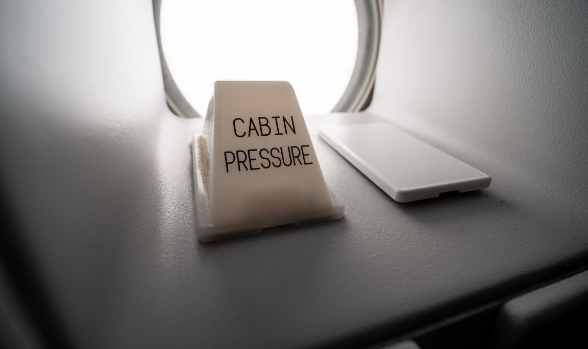Cabin Pressure Control System Components

Air Vehicle’s Environmental Control System Packs force air into the airplane pressure vessel (cabin). Pressurization Control System maintains a safe cabin altitude. This is to ensure that passengers and crew have enough oxygen present at sufficient pressure to facilitate full blood saturation.
Controlling cabin pressurization is accomplished by regulating the amount of air that flows out of the cabin. The major components for the pressurization control are the Cabin pressure controller (CPC), Outflow valve, Safety valve, and Negative pressure relief valve.
The cabin pressure controller is the device used to control the cabin air pressure. Each CPC has its own systems interface and valve motor system. Cabin altitude is normally rate-controlled by the cabin pressure controller up to a cabin altitude of 8,000 feet.
A cabin outflow valve opens, closes, or modulates to establish the amount of air pressure maintained in the cabin.
Pressurization safety valves are used to prevent the over-pressurization of the aircraft cabin. They open at a preset differential pressure and allow air to flow out of the cabin, also act as a dump valve, allowing the crew to dump cabin air manually. On most aircraft, safety valves are set to open between 8 and 10 psid. Some large transport category aircraft cabins may have more than one cabin pressurization safety valve. Pressurization safety valves also called positive pressure relief valves that prevent overpressure damage to the airplane structure. The positive pressure relief valves are fail-safe devices that bleed fuselage pressure overboard if the outflow valve fails closed.
The negative pressure relief valve prevents negative differential pressure (vacuum pressure) damage to the airplane structure. This can prevent structural damage during a rapid descent. The spring-loaded relief valve opens inward to allow ambient air to enter the cabin. Too much negative pressure can cause difficulty when opening the cabin door. If high enough, it could cause structural damage since the pressure vessel is designed for cabin pressure to be greater than ambient.
Ventilation is achieved by controlling the rate at which the air enters the cabin and the rate at which it is allowed to leave. Supply air is the air pumped into the cabin, and if is allowed to leave at a slower rate than it is pumped in then the cabin becomes pressurized. The ventilation system uses differential pressure, cabin to ambient, to remove air by suction.
Pneumatic CPCS

- All control functions and outflow valve actuation are accomplished with pneumatic pressures. Manual override devices in this type of system (for instance, for dumping the cabin) can be either mechanical or electrical solenoid operated.
- Pneumatic actuators powered by deep-convolution diaphragms, or pistons are used in Pneumatic CPCS. By setting the desired cabin altitudes, rate of cabin altitude change and barometric pressure settings the pressure regulator adjust the outflow valves to regulate the air pressure within the cockpit. Adjustments during flight can be made on the regulator during flight can be made by the pilot. There are several pneumatic systems for fail cases such as safety valves, negative pressure relief valves and pressure dump valves.
- Electrical energy is commonly used in this type of system only for lighting the panel of the controller unit and operation of solenoid valves for automatic and manual switching of operational modes.
Electronic CPCS

- All control functions except pressure sensing make use of electrical power. Outflow valve actuation is performed electrically. The cabin pressure controller is an electronic modularized unit incorporating pressure sensing, logic and signal generating circuitry.
- Electric actuators, consisting of servo motors coupled with gear trains, are used in Electronic CPCS. By the utilization of Selector in the pressurization panel, the ECS controller electric signals to the cabin pressure controller which applies pressurization logic on said information to regulate the cabin temperature by adjusting the positioning of outflow valves. Outflow valves could also function as pneumatic operations in; safety valves, negative pressure relief valves and pressurization dump valves.